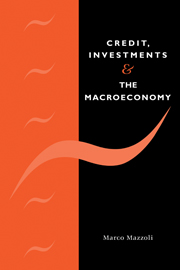Book contents
- Frontmatter
- Contents
- Preface and acknowledgements
- 1 Introduction
- Part I Banks, credit and the macroeconomy: a puzzle
- 2 Credit, financial markets and the macroeconomy: different approaches and a proposed perspective
- 3 Securitization and the empirics of bank credit
- Part II Interactions between credit and industry: firms' market power and banks' liquidity preference
- Part III ‘Inside-the-firm’ interactions between finance and investments
- Summing up …
- Bibliography
- Index
2 - Credit, financial markets and the macroeconomy: different approaches and a proposed perspective
from Part I - Banks, credit and the macroeconomy: a puzzle
Published online by Cambridge University Press: 03 February 2010
- Frontmatter
- Contents
- Preface and acknowledgements
- 1 Introduction
- Part I Banks, credit and the macroeconomy: a puzzle
- 2 Credit, financial markets and the macroeconomy: different approaches and a proposed perspective
- 3 Securitization and the empirics of bank credit
- Part II Interactions between credit and industry: firms' market power and banks' liquidity preference
- Part III ‘Inside-the-firm’ interactions between finance and investments
- Summing up …
- Bibliography
- Index
Summary
Credit and the macroeconomy
The role of the banking system in the transmission of monetary disturbances is the object of a lively debate. While a certain consensus has been established on the fact that monetary policy affects economic activity, at least in the short run, there is no agreement on how monetary policy affects output, prices and employment.
The traditional ‘textbook’ analyses of the monetary policy transmission mechanism are based on IS–LM models (or on aggregate demand and supply frameworks if one assumes price flexibility). Monetary policy interventions by the central bank induce impulses to the economic activity through changes in interest rate in liquid assets first and, in the long run (because of substitutionality among the different financial assets), interest rates. This ‘traditional’ approach, denominated ‘money view’ and based on the conventional Hicks–Modigliani–Patinkin framework, is founded on the assumption of perfect substitution between the different financial assets and neutrality of firms' financial structure. The emphasis is put on the role played by the liabilities of the banking system, directly affected by monetary policy shocks and as a consequence affecting only bank assets.
The ‘credit view’ or ‘lending view’, although not necessarily in conflict with the ‘money view’, is based on the assumption of imperfect substitution between bank credit and securities and, at least implicitly, between internal and external finance. These models are usually based on the assumption of information asymmetries in financial markets and macroeconomic relevance of firms' financial structure.
- Type
- Chapter
- Information
- Credit, Investments and the MacroeconomyA Few Open Issues, pp. 13 - 55Publisher: Cambridge University PressPrint publication year: 1998



